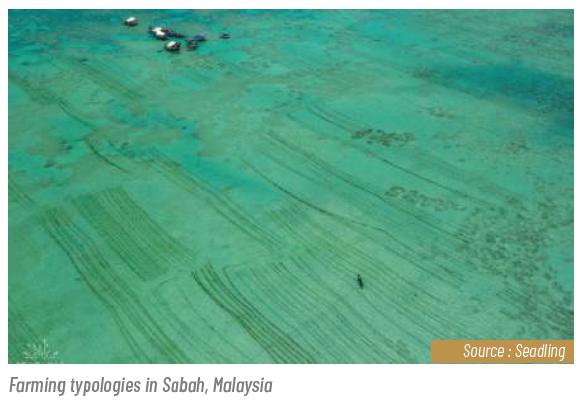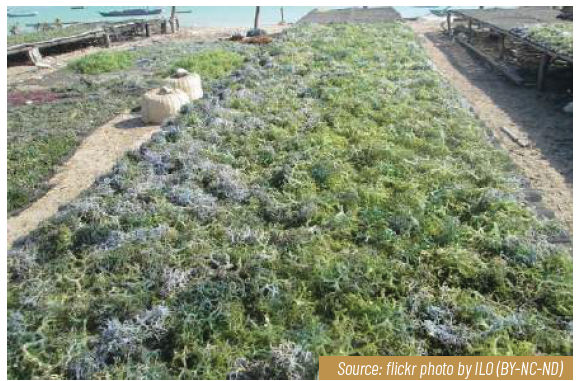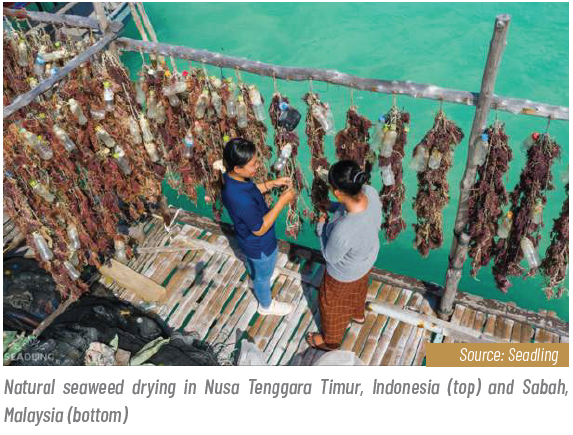Article II 1/2025 - SEAWEED: PROSPECTS FOR DECARBONISATION AND FOOD SECURITY IN SOUTHEAST ASIA

Some have called seaweed “an important piece of the climate puzzle”1, “an environmental powerhouse”2, and the “fastest and least expensive way” for carbon mitigation3. In a 2023 report4, the World Bank added that the global seaweed market could grow by an additional USD 11.8 billion by 2030, and that seaweed has the potential to improve marine biodiversity and alleviate poverty, especially among those most impacted by sea-level rise.5
One-third of global farmed seaweed is produced in Southeast Asia. Can the region’s nations leverage seaweed not only for socio-economic development, but also for food security and decarbonisation?
Current and evolving uses of seaweed
As an ingredient, seaweed is used in both edible and non-edible items. Dried seaweed is sold as hydrocolloids (as carrageenan), which is used as a functional ingredient in food formulation to improve food consistency, as an emulsifier, and to control texture, flavour and shelf life. It is used in pharmaceuticals, cosmetics, and as a dairy and meat texturiser.8 Amongst the most popular species is Gracilaria, which is used as agar to stabilise and thicken food.9
Beyond food ingredients, some seaweeds are used as feed for abalone aquaculture and as a feed additive for shrimp and livestock due to its potential to boost immune systems and enhance growth10. For humans, there are also growing nutraceutical applications.11 Seaweed is also increasingly being used as a base for alternative protein products, including plant-based meat.12
In addition, certain seaweeds can contribute to food security as a biostimulant by increasing the ability of plants to absorb nutrients; this aligns with organic farming.13 It contributes to plant resilience as well (Figure 1); for example, one seaweed species has been found to improve plant health under saline conditions in the Netherlands, boosting root vegetable yields in the face of sea-level rise.14 The World Bank highlights that seaweed bio-stimulants represent a USD 1.9 billion opportunity when used as an alternative to fossil fuel-sourced fertilisers and pesticides.15 Another important way in which seaweed contributes to food security indirectly is by providing ecosystem services for fisheries. It provides food and habitat for marine life and is an effective bioremediation tool that enhances water quality by absorbing nitrogen and other undesirable chemicals.
1 With the Right Tools, Seaweed Can Be an Important Piece of the Climate Puzzle. 2024, March 12. The Nature Conservancy. https://www.nature.org/en-us/what-we-do/our-insights/perspectives/blue-carbon-seaweednature- based-climate-solution/
2 Jacobo, J., DiMartino, J., & DiMartino, J. 2024, May 2. How kelp farms, an “environmental powerhouse,” can help mitigate climate change. ABC News; ABC News. https://abcnews.go.com/US/kelp-farmsenvironmental- powerhouse-mitigate-climate-change/story?id=109824230
3 Huber, B., & Lauren Owens Lambert. 2023, June. Could seaweed be the “fastest and least expensive” tool to fight climate change? Environment. https://www.nationalgeographic.com/environment/article/seaweedfastest- least-expensive-tool-climate-change
4 World Bank. 2023. Global Seaweed: New and Emerging Markets Report, 2023. © Washington, DC: World Bank. http://hdl.handle.net/10986/40187 License: CC BY-NC 3.0 IGO.
5 World Bank. 2023. Global Seaweed: New and Emerging Markets Report, 2023. © Washington, DC: World Bank. http://hdl.handle.net/10986/40187 License: CC BY-NC 3.0 IGO.
6 BFAR. 2021. Seaweed (Kappaphycus) Industry Roadmap 2022-2026. Philippines Bureau of Fisheries and Aquaculture, Department of Agriculture.
7 Rimmer, M. A., Larson, S., Lapong, I., Purnomo, A. H., Pong-Masak, P. R., Swanepoel, L., & Paul, N. A. 2021. Seaweed aquaculture in Indonesia contributes to social and economic aspects of livelihoods and community wellbeing. Sustainability, 13(19), 10946.
8 Qin, Y. 2018. Seaweed hydrocolloids as thickening, gelling, and emulsifying agents in functional food products. In Bioactive seaweeds for food applications (pp. 135-152). Academic Press.
9 Rimmer, M. A., Larson, S., Lapong, I., Purnomo, A. H., Pong-Masak, P. R., Swanepoel, L., & Paul, N. A. 2021. Seaweed aquaculture in Indonesia contributes to social and economic aspects of livelihoods and community wellbeing. Sustainability, 13(19), 10946.
10 Rimmer, M. A., Larson, S., Lapong, I., Purnomo, A. H., Pong-Masak, P. R., Swanepoel, L., & Paul, N. A. 2021. Seaweed aquaculture in Indonesia contributes to social and economic aspects of livelihoods and community wellbeing. Sustainability, 13(19), 10946.
11 Ganesan, A. R., Tiwari, U., and Rajauria, G. 2019. “Seaweed nutraceuticals and their therapeutic role in disease prevention.” Food Science and Human Wellness 8(3) 252–263. https://doi.org/https://doi. org/10.1016/j .fshw.2019.08.001.
12 Good Food Institute. 2021, January 14. Using red seaweed to make plant-based meat. https://gfi.org/ researchgrants/using-red-seaweed-protein-for-plant-based-meat/
13 Zhang, L., Liao, W., Huang, Y., Wen, Y., Chu, Y., & Zhao, C. 2022. Global seaweed farming and processing in the past 20 years. Food Production, Processing and Nutrition, 4(1), 23.
Potential for decarbonisation
Through photosynthesis, seaweed absorbs carbon dioxide. A number of companies and research organisations have been experimenting with the cultivation of seaweed to sequester carbon to sink it in the deep ocean floor in exchange for carbon credits.18 The science of its efficacy and health impacts on marine and aquatic ecosystem is under-studied, however, and researchers and policymakers are cautious about viewing it as a pathway for permanent carbon removal due to the inability to monitor, report and verify.19 At least one US-based company with USD 70 million in investment, has recently shuttered due to its inability to sustain its operations by sale of carbon credits.20
Carbon captured in seaweed biomass used for consumption (as food, feed or ingredients) or combustion (as fuel or bioplastics) is eventually released, and thus cannot be considered as contributing to decarbonisation. While some carbon is sequestered when fronds break off and sink to the seafloor as sediment, research has found that the amounts are small.21 A recent report by the Nature Conservancy and Bain Consulting suggested that, based on current carbon prices (averaging USD 30 per tonne CO2e), carbon markets are unlikely to drive growth in seaweed farming, though this could change if carbon prices were to increase a few-fold.22
Recent research has demonstrated that the use of Asparagopsis taxiformis and A. armata as feed additives can decrease enteric methane production in cattle by up to 80 percent23, though long-term studies are needed to confirm this. Cattle farming contributes approximately seven percent of global greenhouse gas emissions, much of this due to enteric methane production. At least one company has started growing Asparagopsis in Vietnam.24
Seaweed can also potentially mitigate carbon emissions by replacing plastics, petrochemicals and other fossil fuel-based products. Red seaweed biomass could, in a distant future, potentially even be used for biofuel production because its productivity (dry weight per unit area per year) is higher than that of wood and agricultural waste.25 Some seaweeds have high lipid and low lignin content suitable for efficient biofuel production, including Gracilaria, comparable to sorghum and sugarcane26; however, past attempts to commercially produce biofuel from seaweed have not been successful. Other studies have shown that Kappaphycus and pure kappa carrageenan have the potential to be made into biofilms that are suitable for single-use packaging27, though these too have yet to be widely adopted.
As seaweed does not require arable soil or chemical inputs, it is seen as an attractive third-generation feedstock to help power a future bioeconomy. However, the lack of availability of sufficient volumes of seaweed at low prices and consistent quality is a limitation. Even though it is now already being added to bioplastics, the current purchase price of raw materials is a significant barrier, as adoption prices for seaweed-based bioplastics are currently 20-40 percent higher than conventional plastics.28 Scale, and the domestic infrastructure for processing at scale, would be critical to develop a seaweed biofuel and bioplastics industry.
14 Hermans, S. 2024, Jun 4. How to win at Biostim. https://phyconomy.substack.com/p/how-to-win-atbiostim
15 World Bank. 2023. Global Seaweed: New and Emerging Markets Report, 2023. © Washington, DC: World Bank. http://hdl.handle.net/10986/40187 License: CC BY-NC 3.0 IGO.
16 World Bank. 2023. Global Seaweed: New and Emerging Markets Report, 2023. © Washington, DC: World Bank. http://hdl.handle.net/10986/40187 License: CC BY-NC 3.0 IGO.
17 Bindoff, N. L.; Cheung, W. W. L.; Kairo, J. G.; Arístegui, J.; et al. 2019. “Chapter 5: Changing Ocean, Marine Ecosystems, and Dependent Communities” (PDF). IPCC Special Report on the Ocean and Cryosphere in a Changing Climate. pp. 447–587.
18 Chalmin A. 2024, Apr 10. “Dumping biomass in the open ocean is an unproven carbon removal strategy, but that hasn’t stopped companies from selling carbon credits from it”. In Geoengineering Monitor. https://www. geoengineeringmonitor.org/2024/04/marine-geo-biomass-sinking/
19 Pessarrodona, A., Howard, J., Pidgeon, E., Wernberg, T., & Filbee-Dexter, K. (2024). Carbon removal and climate change mitigation by seaweed farming: A state of knowledge review. Science of the Total Environment, 170525.
20 Daly, N. 2024, Jun 24. “Running Tide, which sold carbon credits for sinking seaweed, shuttering operations.” In Seafoodsource.com. https://www.seafoodsource.com/news/environment-sustainability/carbonremoval- company-running-tide-shuts-down-operations
21 Duarte, C. M., Delgado-Huertas, A., Marti, E., Gasser, B., San Martin, I., Cousteau, A., . . . Masque, P. (2023) Carbon Burial in Sediments below Seaweed Farms. Pre-print - bioRxiv. (Referenced through Nature Conservancy report).
22 The Nature Conservancy and Bain & Company. 2023. Analysis of Farmed Seaweed Carbon Crediting and Novel Markets to Help Decarbonize Supply Chains. The Nature Conservancy. https://www.nature.org/ content/dam/tnc/nature/en/documents/SeaweedMarketsAnalysis.pdf
23 Roque, B. M., Venegas, M., Kinley, R. D., de Nys, R., Duarte, T. L., Yang, X., & Kebreab, E. 2021. Red seaweed (Asparagopsis taxiformis) supplementation reduces enteric methane by over 80 percent in beef steers. Plos one, 16(3), e0247820.
24 N.a. 2019. Greener Grazing: Scaling Up Asparagopsis Taxiformis seaweed farming. Greener Grazing. https://www.greenergrazing.org/
25 Yanagisawa, M., Kawai, S., & Murata, K. 2013. Strategies for the production of high concentrations of bioethanol from seaweeds: production of high concentrations of bioethanol from seaweeds. Bioengineered, 4(4), 224- 235.
26 Zhao, Yiru, Nathalie Bourgougnon, Jean-Louis Lanoisellé, and Thomas Lendormi. 2022. “Biofuel production from seaweeds: a comprehensive review.” Energies 15, no. 24 (2022): 9395.
27 Lomartire, S., Marques, J. C., & Gonçalves, A. M. 2022. An overview of the alternative use of seaweeds to produce safe and sustainable bio-packaging. Applied Sciences, 12(6), 3123.
28 World Bank. 2023. Global Seaweed: New and Emerging Markets Report, 2023. © Washington, DC: World Bank. http://hdl.handle.net/10986/40187 License: CC BY-NC 3.0 IGO
Southeast Asia’s seaweed industry
Indonesia and the Philippines are the second and fourth-largest seaweed producers in the world, respectively. Malaysia, Vietnam, Cambodia, and Timor Leste also produce seaweed (Table 1). Indonesia alone produces more than 75 percent of global cultivated tropical seaweed.30 Southeast Asia’s seaweed production mainly consists of tropical species of Gracilaria and Eucheumatoids. These are used for direct consumption, feed for aquaculture, or processing into agar and carrageenan. The main export market is China, which is also a major producer, while being a net importer. 31
Seaweed is mainly farmed as an alternative income-generating activity for hundreds of thousands in the region. It is commonly farmed by women and is seen as an efficient use of family labour. Due to seaweed farming’s contribution to rural livelihoods and its economic potential, the governments of Indonesia, Philippines, Malaysia and Vietnam have recently been motivated to support seaweed production. Most Southeast Asian seaweed farmers practise a very basic form of cultivation, and any improvements could potentially improve yields significantly.
Vietnam is targeting to harvest half a million tonnes of seaweed annually by 2030.40 Malaysia, on the other hand, is lacking in serious government direction to expand the seaweed industry, even though it was the thirdlargest producer of carrageenan seaweed in the world in 201041, now dropping to the top 20. While R&D has been taking place in Malaysia, it has reportedly not translated into production or resulted in quality improvements for the industry.42
29 Zhang, L., Liao, W., Huang, Y., Wen, Y., Chu, Y., & Zhao, C. 2022. Global seaweed farming and processing in the past 20 years. Food Production, Processing and Nutrition, 4(1), 23.
30 Indonesia Seaweed. 2018. Indonesia Seaweed Infographic. https://www.indonesiaseaweed.com/wpcontent/ uploads/2018/09/Infographic-Seaweed-A4.pdf.pdf
31 Zhang, L., Liao, W., Huang, Y., Wen, Y., Chu, Y., & Zhao, C. 2022. Global seaweed farming and processing in
the past 20 years. Food Production, Processing and Nutrition, 4(1), 23.
32 Zhang, L., Liao, W., Huang, Y., Wen, Y., Chu, Y., & Zhao, C. 2022. Global seaweed farming and processing in
the past 20 years. Food Production, Processing and Nutrition, 4(1), 23.
33 Nguyen Van, T. (2014). Seaweed diversity in Vietnam, with an emphasis on the brown algal genus
Sargassum (Doctoral dissertation, Ghent University).
34 Global Production - Seaweed Insights. (2023, August 8). Seaweed Insights. https://seaweedinsights.com/
global-production/
35 Menteri Hukum dan Hak Asasi Manusia. 2017. Peta Panduan (Road Map) Pengembangan Industry
Rumput Laut Nasional Tahun 2018-2021. https://peraturan.bpk.go.id/Home/Details/108806/perpres-no-33-
tahun-2019
36 Rimmer, M. A., Larson, S., Lapong, I., Purnomo, A. H., Pong-Masak, P. R., Swanepoel, L., & Paul, N. A. 2021.
Seaweed aquaculture in Indonesia contributes to social and economic aspects of livelihoods and community
wellbeing. Sustainability, 13(19), 10946.
37 Indonesia’s Jokowi to push for domestic seaweed processing, including for fuel. 2023. CNA. https://www.
channelnewsasia.com/asia/indonesia-jokowi-domestic-seaweed-processing-fuel-3891606
38 BFAR. 2021. Seaweed Industry Roadmap 2022-2026. Philippines Bureau of Fisheries and Aquaculture,
Department of Agriculture.
39 BFAR. 2021. Seaweed Industry Roadmap 2022-2026. Philippines Bureau of Fisheries and Aquaculture,
Department of Agriculture.
40 Chu Khôi. 2024, January 22. Vietnam targets harvesting 500,000 tons of seaweed by 2030. Vietnam
Economic Times | VnEconomy. https://en.vneconomy.vn/vietnam-targets-harvesting-500-000-tons-ofseaweed-
by-2030.htm
41 Shabudin, M F, Kasim J, Nor A M. 2023. Seaweed farming offers an avenue toward greater food security and
healthier diets in Malaysia. https://iss2023.net/2022/08/22/seaweed-farming-offers-an-avenue-towardgreater-
food-security-and-healthier-diets-in-malaysia/
42 Based on interviews.



43 BFAR. 2021. Seaweed Industry Roadmap 2022-2026. Philippines Bureau of Fisheries and Aquaculture,
Department of Agriculture.
Recommendations to develop the industry
- Regional collaboration on R&D and commercialisation of new products from tropical seaweed species. Despite existing national seaweed R&D programmes, industry stakeholders highlight that there has not been a breakthrough in commercial seaweed species in the last 50 years. Of the 12 000 seaweed species, only 12 account for more than 95 percent of production46, and only five are farmed in Southeast Asia.47 New products have emerged but have yet to be commercialised. The region is also heavily dependent on carrageenan markets; this is risky as there is always the potential for other food additives to replace it. For example, there has been pressure in the United States for the last decade to ban the use of carrageenan in organic foods, due to (disputed) reports by some scientists that it causes inflammation in the digestive tract48. Such a ban may critically disrupt demand for Eucheumatoids. New off-takers are urgently needed to avoid the collapse of seaweed demand should disruptions occur. Regional collaboration on R&D is needed to avoid duplication of efforts and to expand the variety of seaweeds being researched and commercialised. This is particularly urgent as higher-yielding, resilient cultivars are needed to adapt to the ocean warming and acidification which are projected to occur. This aligns with ABEF’s Blue Strategy 2: Blue Science, Technology and Innovation.
- Harmonisation of industry standards. While the standards for seaweed in food and pharmaceuticals are relatively wellestablished, new industry standards are needed for its use for biostimulants, feed additives, bioplastics, biofuel and others. This will enable the industry to grow faster once downstream players use these standards to compare different seaweed-derived products against fossil fuel-based incumbents. As this space is still nascent, it is beneficial to set standards early before practices become entrenched.
- Creation of enabling environments for downstream industries and market linkages. Currently, seaweed is exported mainly in its primary form without industrial processing. This exposes farmers to highly volatile global prices. For example, a tonne of Kappaphycus was sold for USD 811 in 2007 but the price tripled to USD 2 166 in 2008 and then dropped to USD 1 208 in 2009.49 Creating an enabling environment for in-region industrial-scale processing facilities, for instance, by levelling the playing field between domestic and say, Chinese companies through tax treatment50, will benefit its economies and spur new downstream manufacturing activities.
- Leveraging seaweed farmers for more accurate coastal monitoring. Southeast Asian nations lack the resources to monitor their coastal waters, even as their residents depend on marine resources for between 20 and 50 percent of their protein.51 In the United States, at least one organisation, GreenWave, is leveraging its network of seaweed farms to capture data, which is then licensed to interested parties. Similarly, governments could gather data from seaweed farms to understand the environmental conditions of their coastal waters and address pollution, long-term warming, or acidification trends. Establishing the monitoring ecosystem and the data collection capacity may take time; however, it does align with ABEF’s Blue Strategy 1 for Blue Conservation Management.
44 KKP (Indonesia). 2024. Production volume of seaweed in Indonesia from 2011 to 2021 (in million metric tons) [Graph]. kkp.go.id
45 Channel, MARSAVE. 2021. “Ten Seaweed Industry Development Lessons from Indonesia to the World.” YouTube Video. YouTube. https://www.youtube.com/watch?app=desktop&v=MPfVEwxylwY.
46 Seaweed Insights. Nd. https://seaweedinsights.com/global-production/
47 BFAR. 2021. Seaweed Industry Roadmap 2022-2026. Philippines Bureau of Fisheries and Aquaculture, Department of Agriculture.
Conclusion
Southeast Asia could gain economically from these developments, but only if governments in the region take a longer-term view. The focus should be to collaborate and create an enabling environment for seaweeds and their derived products to deliver their sustainability benefits over their fossil-fuel-based counterparts. This would require restructuring the industry to capture downstream processing and manufacturing activities but as operations become more feasible, further investment will be attracted into the industry to improve production quality, which in turn would improve the applications of seaweed-derived products.
Further, while some Southeast Asian nations have plans to grow the industry, the industry could be considerably boosted by regional cooperation in R&D (including for genetic improvement of tropical species) and commercialisation, industry standards and market linkages. This would improve resilience, harmonise standards for product quality, and create enabling environments for downstream industries and market linkages.
Data derived from seaweed farming could also be used for coastal monitoring. These actions align with the ASEAN Blue Economy Framework and to achieve the desired objectives, governments need to support the aforementioned activities. Additionally, given the challenges that climate change poses to coastal communities in the region, enabling the seaweed industry to grow in ways that prioritise local development and resilience to climate change is an opportunity that regional governments cannot afford to miss.




























